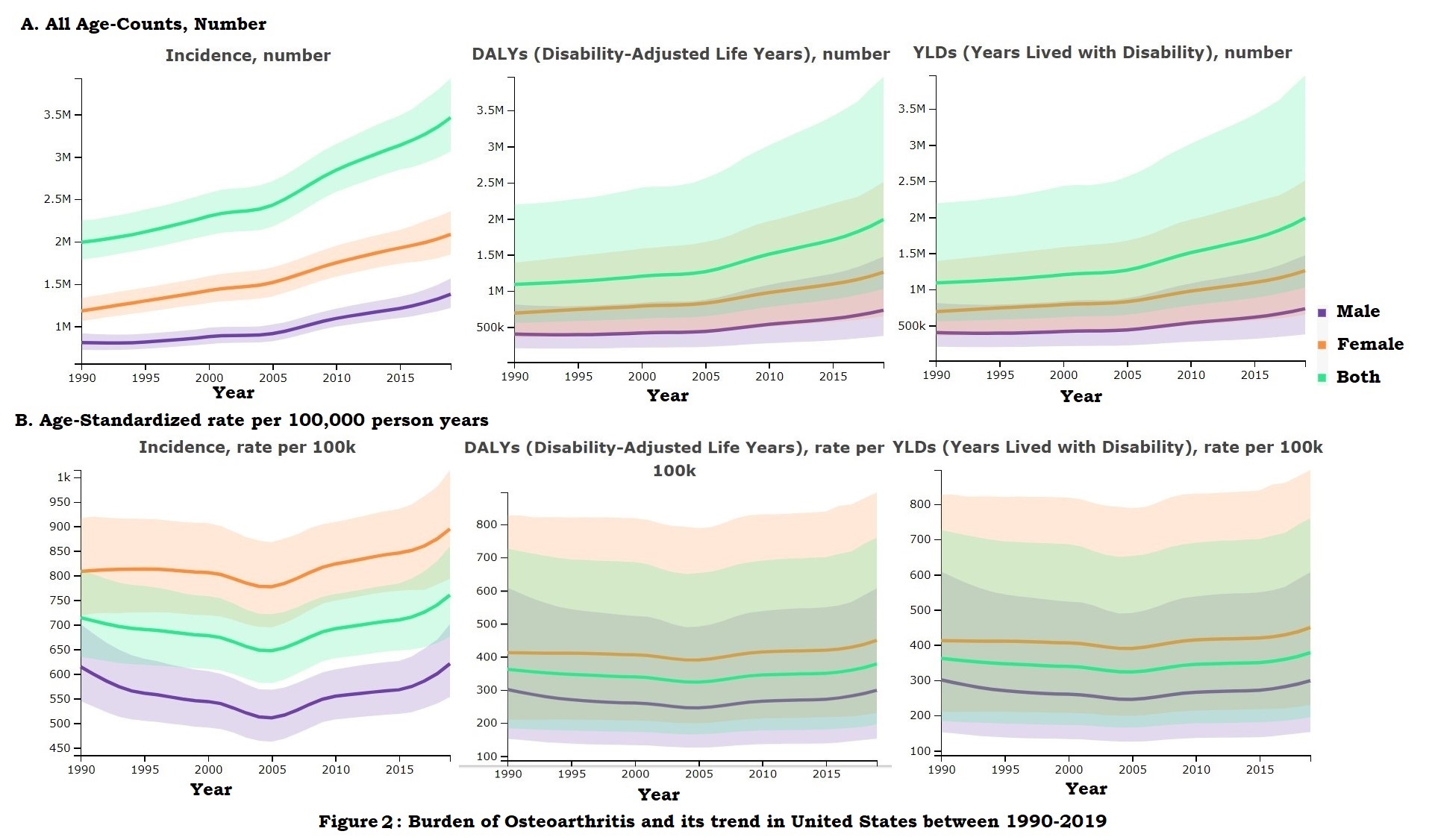Session Information
Session Type: Poster Session C
Session Time: 9:00AM-11:00AM
Background/Purpose: Osteoarthritis (OA) is a prevalent and debilitating musculoskeletal condition that has imposed a significant burden on the United States (US) healthcare system. This study aims to explore the burden and trends of osteoarthritis in the US from 1990 to 2019.
Methods: Using the Global Burden of Disease methodology, this analysis presents a comprehensive overview of the Prevalence, Incidence, Disability adjusted life year (DALYs), Years lived with Disability (YLDs) by age, sex, year across the US from 1990-2019. All estimates were presented as total counts and age-standardized rates per 100 000 population, with uncertainty intervals (UIs).
Results: The prevalence cases of total osteoarthritis in the US nearly doubled from 28,873,208 (95%UIs: 25,939,261-32,228,468) in 1990 to 51,865,888 (46,804,271-57,860,984) in 2019. Similarly, the incidence of osteoarthritis increased from 1,990,039 (1,789,372-2,247,569) in 1990 to 3,462,236 (3,060,905-3,923,793) in 2019. The YLDs due to osteoarthritis also saw an upward trend, rising from 1,087,979 (556,601-2,194,304) in 1990 to 1,986,342 (1,023,960-3,964,292) in 2019. The annual percentage change (APC) in DALYs increased by 83% (75%-91%) from 1990 to 2019, indicating a substantial rise in the burden of osteoarthritis. The APC of age-standardized incidence rate (ASIR) increased by 6% (3%-10%), suggesting a steady growth in the occurrence of new cases. Among the states, Massachusetts experienced the highest incidence APC (13%), followed by California (12%) and Minnesota (10%) from 1990 to 2019. Interestingly, North Dakota was the only state that reported a decrease in the APC of ASIR by 2%. When analyzing the age-standardized DALYs rate (ASDALR), California exhibited the highest APC (12%), followed by Massachusetts (10%). Nevada had the highest APC in total incidence cases (226%), with Arizona closely behind at 158%. In contrast, the District of Columbia had the lowest APC in total incidence cases (23%) from 1990 to 2019. Regarding gender differences, females had a higher total number of incidence cases in the APC analysis (76% vs. 70%), while the increase in DALYs was similar for both males and females. Looking at specific age groups, Nevada and Alaska had the highest APC increase in incidence among individuals aged 95 and above, while North Dakota had the lowest APC in the 40-44 age group for females. For males, Nevada and Alaska had the highest APC increase in incidence among aged 95 and above, while Vermont had the lowest in the 40-44 age group.
Conclusion: In the US, the overall burden of osteoarthritis has steadily increased over the past three decades, with a notable variation in burden observed across different states. It is crucial to prioritize public health initiatives that promote healthy aging, early detection, and appropriate interventions. This includes raising awareness about the risk factors associated with osteoarthritis, implementing strategies to promote physical activity and healthy lifestyles, and ensuring equitable access to effective treatments and therapies.
To cite this abstract in AMA style:
Gadhiya D, Patel U, Chhayani H, Shah K, Patel S, Adedara V, Patel D, Desai H, Chittipolu S. Statewide Burden of Osteoarthritis in United States Between 1990-2019: A Systematic and Comparative Benchmarking Study [abstract]. Arthritis Rheumatol. 2023; 75 (suppl 9). https://acrabstracts.org/abstract/statewide-burden-of-osteoarthritis-in-united-states-between-1990-2019-a-systematic-and-comparative-benchmarking-study/. Accessed .« Back to ACR Convergence 2023
ACR Meeting Abstracts - https://acrabstracts.org/abstract/statewide-burden-of-osteoarthritis-in-united-states-between-1990-2019-a-systematic-and-comparative-benchmarking-study/



